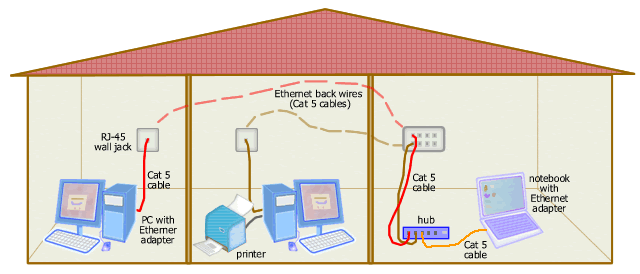Home Networking Guide : Ethernet

Figure: Ethernet Home Network.
In this example the house already has Ethernet wiring ready
with Ethernet jack (RJ45 female connector) in every room.
Power jacks and power cables are not shown in this diagram for simplicity.
Ethernet is a wired LAN technology that follows IEEE 802.3 standard.
There are various types of Ethernet cabling. Ethernet can run
over coaxial cable, twisted pair cable, and fiber optic cable. But most
Ethernet networks are implemented using twisted pair cables.
10BaseT and
100BaseT are the most common
Ethernet cabling standards used in home networks. Both usually use UTP (unshielded
twisted pair) Cat 5 cable.
10BaseT and 100BaseT provides data rate of 10 and 100 Mbps
respectively, fast enough for running most multimedia applications
over a home network. However, if you want more, you still have a
chance to get faster speed, that's using 1000BaseT (Gigabit
Ethernet) which can give you 1 Gbps data rate. Gigabit Ethernet
has long been used in big corporate networks and ISPs, and now it
is expanding its user base to smaller networks due to the increasing
product availability with lower price. Computer manufacturers have
started shipping new desktop or laptop models with built-in
10/100/1000BaseT network adapters.
Both common Ethernet cabling standards use star topology
in which each computer or device is connected to a
hub or a switch as a central connection point.
Most Ethernet hubs or switches in the market support both 10BaseT and
100BaseT. They can switch from/to 10BaseT and 100BaseT automatically
depending on line condition.
This feature is called auto-sensing. Look at the Related Links
below to see the difference between hub and switch.
Please note though, you don't need to buy a separate hub or switch if
you already have a broadband router that has built-in switch. This
device will connect all your computers to the Internet. However, you
must check the number of available ports, whether it is adequate for
connecting all computers.
The maximum length of an Ethernet cable segment (that is from each
computer to the hub) is 100 meters. You must
use a straight-through cable for connecting each computer to a
hub or switch. A straight-trough cable is a Cat 5 cable or better (i.e. Cat
5e, Cat 6) that is pinned identically in both ends, either
following EIA/TIA-568A or 568B wiring scheme.
|